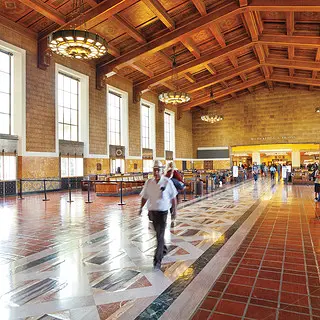
From Coffee Shops to Churches, SurveyLA Documents the Diversity of Los Angeles
As the jurors of the 2017 Richard H. Driehaus Foundation National Preservation Awards deliberated, they kept returning to the idea of community. Architecturally significant, impeccably tailored historic buildings are, and always will be, important to save, but the field of preservation is increasingly widening its focus to include places that affect daily life for large numbers of people. In the end, that’s exactly what the jurors chose to highlight. A groundbreaking historic-resources survey conducted by the city of Los Angeles (story below) is one of three winners that embody this more holistic view of preservation.
You know the usual architectural icons in Los Angeles: The Art Deco, Mission Revival, and Spanish Colonial Revival–style Union Station, John Lautner’s Modernist Chemosphere House, and the Space Age–style Theme Building at Los Angeles International Airport are a few famous examples.
But then there are places such as the small Victorian cottage at 1442 West 36th Place in South L.A. Built in 1895, it was once the home of the Seinan Judo Dojo, a legendary judo club where teachers helped popularize martial arts in the United States during the years surrounding World War II.
Not far away, a two-story brick building on the corner of Central Avenue and 41st Street houses a furniture shop and an appliance store. Shortly after it was built in 1906, it held the offices of the California Eagle Publishing Company, which printed what was once the largest African-American newspaper in the state.

photo by: Tom Fowlks
The former headquarters of California Eagle Publishing.
These sites are among the 30,000-plus historic resources identified through SurveyLA, the Los Angeles Historic Resources Survey. The 10-year project—partly funded by a $2.5 million matching grant from the J. Paul Getty Trust, with substantial technical and advisory support from the Getty Conservation Institute (GCI)—surveyed more than 880,000 parcels of land across 500 square miles of Los Angeles, making it the largest survey of its kind ever conducted in the United States. It uncovered a host of resources of architectural, historical, and cultural importance—from houses, churches, and theaters to bridges, coffee shops, air-raid sirens, and car washes.
“There’s this persistent and unfortunate myth about Los Angeles that we’re a city with little or no significant architecture,” says Ken Bernstein, a Los Angeles city planner and manager of the city’s Office of Historic Resources (OHR). “But this survey really explodes that. What we found is that every single community in Los Angeles has a rich array of unique historic resources.”

photo by: Tom Fowlks
The Googie-style sign at Johnie's, a coffee shop that often appears in movies and television shows.
In the earlier stages of the survey, Bernstein and Janet Hansen, deputy manager of the OHR, wrote the city’s first-ever historic-context statement to set a framework for identifying and evaluating historic resources. Working with other city agencies, they developed a custom geographic information system (GIS) mobile application for surveyors to use in the field. And in collaboration with the GCI, they created the country’s most advanced digital historic-resources inventory and management system, HistoricPlacesLA.
To gather research, Bernstein and Hansen reached out to the people who know the city best: its residents. They recruited 30 new members for the OHR’s Volunteer Speakers Bureau. These project ambassadors taught the public about the survey and encouraged people to submit information on individual properties or neighborhoods through the SurveyLA website.
“This is Los Angeles: You have subject matter and geographic area experts on almost every topic you can think of here, and we wanted to get them on board,” Hansen says.
In addition, more than 200 volunteers provided research, writing, photography, surveyor assistance, and basic administrative tasks. And a host of professional consultants helped to conduct the surveys, canvassing the city block by block.

photo by: Barry Schwartz
The exterior of Union Station Los Angeles; the interior is shown at top.
While SurveyLA was conceived primarily as a tool for better city planning, Bernstein and Hansen see many additional uses for the data: disaster preparedness training, location scouting for film shoots, and cultural tourism. They also believe it can serve as a model for other cities and towns.
Though the survey wrapped up early this year, the team’s work is far from done. In the coming months, a data manager will continue to load the survey’s findings into the HistoricPlacesLA database. After that, Hansen says, the goal is to keep maintaining and updating the survey findings.
“Generally, you need enough time to pass before gaining perspective on whether or not something is historically or architecturally significant,” she adds. “Just think, in 2040 we’ll be looking at sites from 2000 and assessing those for significance.”The Richard H. Driehaus Foundation National Preservation Awards are supported by the Richard H. Driehaus Foundation. The other 2017 winners are Washington Hall and Hamnett Place.



